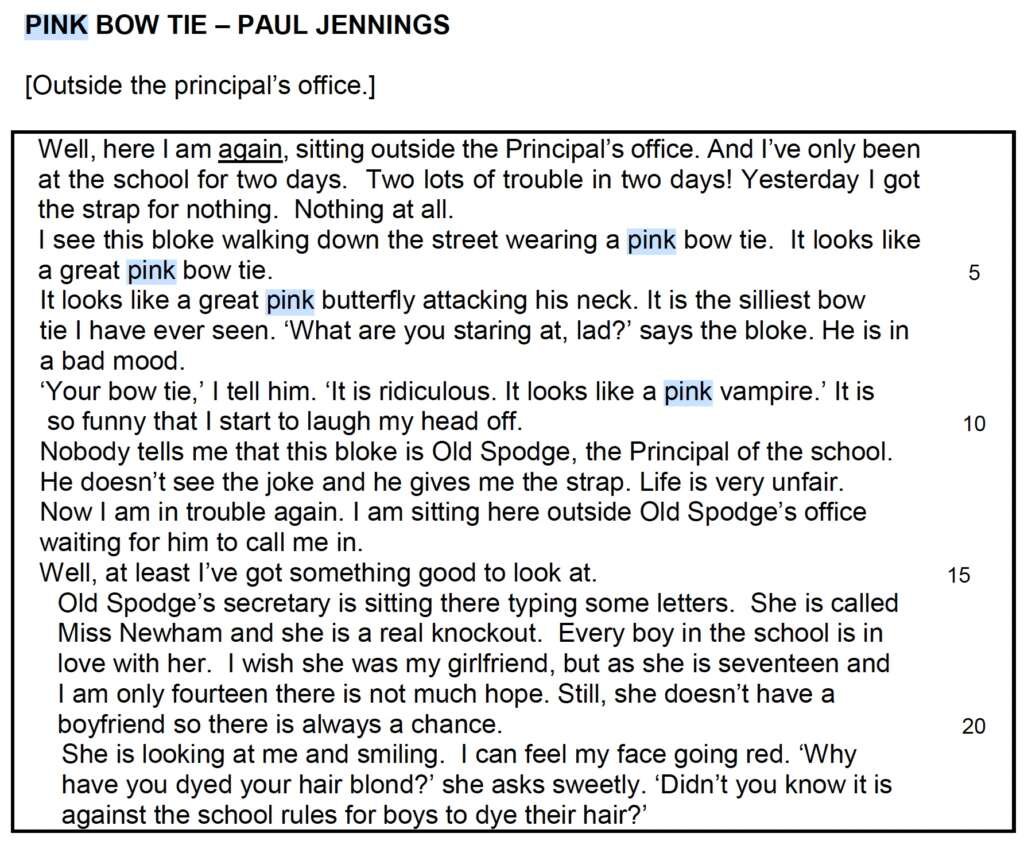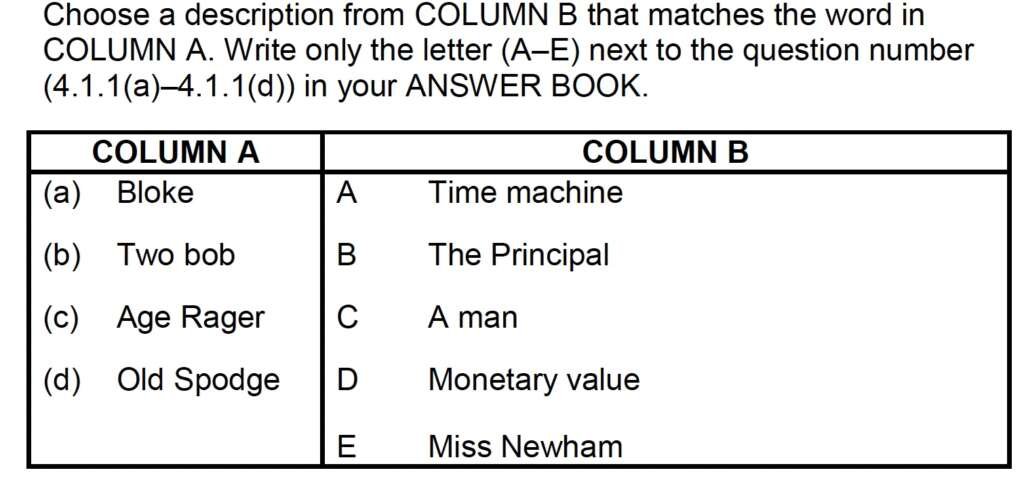Pink Bow Tie Short Story Questions and Answers pdf
Pink Bow Tie Short Story Questions and Answers pdf
Questions and Answers
- Question: How did the narrator end up in trouble during his first two days at his new school?Answer: The narrator first landed in trouble for making fun of the principal’s pink bowtie, not realizing that the man he was mocking was the principal of the school. The second time he was called to the principal’s office was because he dyed his hair blonde, which was against the school rules.
- Question: What is the Age Rager and how does it affect the characters in the story?Answer: The Age Rager is a machine that has the power to change a person’s age, making them older or younger according to the user’s wish. It affected several characters in the story: a kid used it to age himself into an adult, an old lady used it to become a sixteen-year-old girl, and a mean guy turned himself first into an infant, then aged rapidly and died. The principal, Old Splodge, also appears to have used it to become a young man, as suggested by the ending.
- Question: How does the narrator justify his violation of school rules?Answer: The narrator justifies his blonde hair by recounting an extraordinary story involving an Age Rager that resulted in his hair turning white with fear, which then turned blonde.
- Question: What are the unexpected twists in the story?Answer: Several unexpected twists occur in the story. Firstly, the boy’s tale of how his hair turned blonde is quite surprising. The most significant twist is at the end of the story, where it is suggested that the principal, Old Splodge, has used the Age Rager to become a young man and is possibly dating his secretary, Miss Newham.
- Question: What is the significance of the pink bowtie in the story?Answer: The pink bowtie is initially significant as it’s the reason the narrator gets into trouble on his first day, for mocking it while unaware that its wearer is the school’s principal. At the end of the story, it takes on new significance when Miss Newham’s boyfriend sports a pink bowtie, suggesting that he might be the transformed Principal Splodge.
- Question: How is humor used in “Pink Bow Tie”?Answer: Humor in “Pink Bow Tie” is derived largely from the absurdity of the situations, the main character’s irreverent attitude, and the unexpected twist at the end. The exaggerated use of the Age Rager and its bizarre effects on the characters also contribute to the humorous tone of the story.
- Question: What does the story’s ending suggest about the narrator’s previous account?Answer: The ending suggests that the narrator’s tale about the Age Rager, which initially seemed made up, might have been true. The principal’s disappearance and the appearance of a young man wearing a pink bow tie and dating Miss Newham hint that Principal Splodge used the Age Rager to become young.
- Question: How does the author create suspense in the story?Answer: The author creates suspense by presenting a series of unusual events, including the narrator’s encounter with the Age Rager, and maintaining a certain level of ambiguity about whether the events truly happened. The ending also leaves readers wondering about the truth of the narrator’s story and the fate of the principal.
- Question: How does the narrator’s character evolve throughout the story?Answer: The narrator begins as a somewhat rebellious student, mocking the principal’s bowtie and violating school rules by dyeing his hair. As the story progresses, he shows himself to be creative and quick-thinking, coming up with an imaginative story to explain his hair color. Despite facing potential punishment, he remains steadfast in his truth. The narrator also exhibits empathy when he tries to prevent the mean guy from misusing the Age Rager. By the end, he appears somewhat bewildered by the strange turn of events but remains resilient and adaptable in the face of the unexpected.
- Question: How does the author, Paul Jennings, use tone and style to engage the reader in “Pink Bow Tie”?Answer: Paul Jennings uses a simple, colloquial tone in “Pink Bow Tie”, making the narrative sound like a personal recounting of an actual incident. This, combined with the surprising twists, bizarre incidents, and element of humor, keeps the readers engaged and invested in the story. Despite the fantastical elements, the narrative remains plausible enough to keep readers guessing and adds to the story’s thrill. This balance between the absurd and the believable is a key aspect of Jennings’ distinctive style.
Questions and Answers from Previous Question Papers


Answers:
(a) C/ A man √
(b) D/ Monetary value √
(c) A/ Time machine √
(d) B/ The Principal
Questions and answers:
- Refer to line 1. (‘Well, here I…the Principal’s office.’) (a) Give a reason why the word ‘again’ is underlined in the sentence. (1) (b) How does the word ‘Well’ in line 1 contribute to the tone of the narrator’s voice? (1)
- (a) The bow tie is compared to a pink butterfly because of its colour and shape. √
- (b) A butterfly is seen as a gentle insect. It portrays beauty and tenderness instead of the harsh work of attacking. √√
- Refer to line 6. (‘It looks like…attacking his neck.’) (a) Explain the simile in this line. (1) (b) Write down TWO things why the word ‘attacking’ is not fitting in this comparison. (2)
- (a) The bow tie is compared to a pink butterfly because of its colour and shape. √
- (b) A butterfly is seen as a gentle insect. It portrays beauty and tenderness instead of the harsh work of attacking. √√
- Refer to line 17. (‘Miss Newham and…a real knockout.’) When the narrator refers to the secretary as a ‘real knockout’ (line 17) he means that she is… A) taking part in a boxing match. B) extremely beautiful. C) fearful. D) typing fast. (1)
- B/Extremely beautiful. √
- Refer to line 18. (‘I wish she…is seventeen and…’) Write down TWO reasons that prevent the narrator from having Miss Newham as his girlfriend. (2)
- She is employed at the school and he is a student. √√ He is too young.
- From your knowledge of the story as a whole: Write down ONE good thing and ONE bad thing that happened at the end of the story. (2)
- Spodge disappeared. √ Miss Newham got a boyfriend. √
- The principal was angry because the boy’s hair changed from black to white. In your opinion, is it necessary for the Principal to call the boy to the office for changing the color of his hair? Discuss your view. (3)
- The boy has disobeyed the rules of the school. The school’s code of conduct says that boys may not change the colour of their hair. Respectable hair rules accompany good discipline; that explains why the boy is in the Principal’s office ‘again’. The boy was taken out of class during academic time. √√√ Open-ended.
- OR It is not necessary for the Principal to summon the boy to the office. Changing the color of hair is an everyday occurrence. The school should relax its rules and concentrate more on academics.
- (a) It indicates that it is not the first time that the narrator is in trouble. √ (b) It gives a tone of meditativeness/reflectiveness/thinking. √
PDF Downloads
ENGL-FAL-P2-MEMO-GR11-NOVEMBER-2017-1.pdf
Download
ENG-FAL-P2-GR11-NOVEMBER-2017-3.pdf
Download





